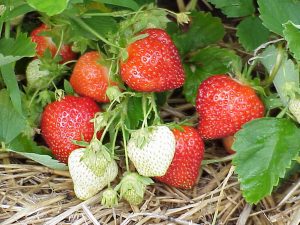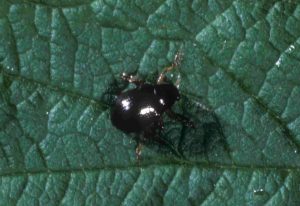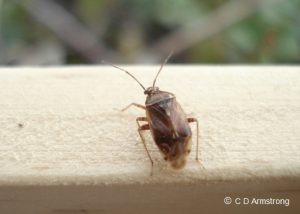Strawberry IPM Newsletter No. 2 – May 25, 2018
 Strawberry IPM Newsletter No. 2 – May 25, 2018
Strawberry IPM Newsletter No. 2 – May 25, 2018
Click on photos to enlarge.
FULL BLOOM IN SOUTHERN FIELDS
Time to Protect Blossoms from Gray Mold Infection
Berry Growers Twilight Meeting
Wednesday, June 6, 2018 at 5:00 p.m.
Pineland Farm in New Gloucester, Maine
Situation:
Very variable weather predominates, with mixed temperatures and cloudy days, but little rainfall in most areas. Many fields experienced one or two frost events last weekend, but growers were ready and had irrigation or row covers for protection. Early fields in southern Maine are well into bloom, with flower buds just opening in later varieties. Many growers have applied their first fungicide application for gray mold. Once spray materials have dried on the plants, they are generally considered “rainfast”, unless there is more than one inch of rainfall. Once more than one inch of rain has fallen, or there has been significant shoot or flower growth that is unprotected since the last application, another fungicide application should be applied to assure adequate protection. Remember to alternate fungicide and insecticide chemical families to prevent the development of pest resistance.
Twilight Meeting Wednesday June 6th will be held at Pineland Farm, 752 Mayall Road, New Gloucester, Maine 04260. Justin Gray, Manager of Pineland Farms Produce Division will discuss berry and vegetable production on this intervale site with sandy soils and extensive irrigation engineering. The farm markets both locally thorough U-pick and a farm market, and supplies large market chains through much of the season, specializing in berries, sweet corn and pumpkins. We will also get an update on the berry pest situation around the state, and have an opportunity to look over the equipment they use and have adapted for their operation. The meeting will run from 5:00 p.m. to 7:00 p.m. We anticipate that two pesticide applicator recertification credits will be awarded for the meeting. Hold the date!
Strawberry bud weevil or “clipper” activity has been low in most fields that we’ve scouted this week. Only one field in Dresden was over the threshold of more than 1.2 clipped buds per two feet of row. We are seeing the small holes in the petals of opening flowers that indicate clipper feeding activity in some fields, especially along the border rows, but they are just starting to lay eggs and clip buds. Expect clipper damage to increase as temperatures warm and late blooming varieties come into bloom. Insecticide options for clipper include Lorsban®, Brigade®, Bifenture®, Danitol®, Sevin® and PyGanic®. Raspberry and blackberry growers beware; clippers will also attack the buds of these plants, although they do not appear to cause as much significant injury.
- Tarnished Plant Bug; photo by Charles Armstrong
Tarnished plant bug activity has been low so far, this season. We have adult bugs in most fields, but so far only a few, early instar nymphs. The nymphs can be hard to find, especially if the plants are wet. Young nymphs are very small (2 mm), active, yellow-green insects. It is important to scout for them regularly, as they can appear very quickly. The threshold for nymphs is 4 or more flower clusters infested per 30 sampled. Start scouting any field with open flowers now. Insecticide options for tarnished plant bug include malathion, Assail®, Brigade®, Bifenture®, Dibrom®, Danitol®, and PyGanic®.
Two-spotted spider mites have been found in most of the fields we scouted this week, but mostly in fairly low numbers. Only one field exceeded the recommended spray threshold. Mites typically proliferate under hot, dry conditions like we had last fall, so fields may have harbored a high mite population. Once temperatures become warmer we may see more problems with mites. It is important to scout for mites regularly. If 25% of leaves sampled (e.g. 15 out of 60) have any mites, a spray should be applied. Chemical control options for two-spotted spider mites include Acramite®, Savey®, Zeal®, Portal®, Vendex®, Oberon®, Brigade®, and Danitol®. Be sure to use enough liquid and pressure in the spray to get good coverage on the undersides of the leaves.
Cyclamen mites: We have seen some light symptoms of cyclamen mite injury this week, but haven’t found any live mites yet. Heavily infested plants show weak growth and shrunken, crinkled leaves. These mites are very small and reside in the crown of the strawberry plant, feeding on the developing leaves and flower buds. They are very hard to see, even with magnification. Portal® can be effective, but must be applied in lots of water to be sure that the material is carried down into the crowns where these mites reside.

Strawberry rootworm (not root weevil) adults and feeding injury have been found on strawberry leaves in some fields this spring. The adult stage of this insect is a small (1/8”) dark brown beetle. The beetles feed on strawberry leaves during the spring and late summer, causing numerous small holes in the leaves. The adults in fields now will soon lay eggs. The larvae are small grubs that feed on the roots of strawberry plants, causing them to be stunted and weak. If these beetles and/or feeding injury is prevalent in a field, a treatment is recommended. Sevin 50WP® is registered for control of this pest. Sprays can be timed to also control strawberry bud weevil. Strawberry rootworm should not be confused with root weevil, a larger insect that causes much more serious damage when present in a field.
Diseases: As the fields come into bloom it is important to protect the flowers against infection by spores of the gray mold fungus, Botrytis cinerea. Most fruit infections take place through the flowers, so control efforts should be focused on the bloom period. Two to three sprays of fungicide are typically required to provide good protection. The first spray is usually applied at 5-10% bloom, followed by a second application at petal fall. Additional applications may be applied if there is significant rainfall between or following these two sprays.
Leather rot (Phytopthora cactorum) may become a problem in fields where standing water is common during bloom and fruit development, especially if the fields were not mulched last fall. Incidence of leather rot can be reduced by applying straw mulch between the rows to prevent berries from touching the soil and reducing soil splashing onto the berries. Foliar sprays of Aliette®, Prophyt® or Phostrol® may be applied during bloom and fruit development to prevent leather rot when there has been excess moisture in a field, especially those with a history of this problem.
Powdery mildew: We haven’t yet seen early symptoms of this fungus disease in fields. However, it could become prevalent when warmer weather arrives. It may first appear as purple or red blotches on the leaf and flower stems. Later, upward curling leaves and white, powdery growth on the undersides of the leaves becomes evident. Check your fields for pinkish purple leaf and flower stem lesions as new leaves emerge. Pristine®, Cabrio®, Topsin-M®, captan, Procure®, and Torino® are registered to control powdery mildew.
Leaf spot is a fungal disease characterized by small purple spots with white centers on the leaves. The symptoms are often first visible on the older, lower leaves but often spread throughout the foliage. Spots or lesions may also appear on the leaf and flower stems. The fungus overwinters on older leaves and spreads with rain splashing in the spring. Severe infections can weaken plants, reducing fruit size, yield, and winter survival. We haven’t seen much leaf spot in fields this spring. Varieties vary quite a bit in susceptibility to this disease. If you see leaf spot in your field, you should consider using a fungicide that will provide control as part of your spray program for gray mold. Products such as Captan®, Luna Sensation®, Mervion® and Pristine® have activity on both diseases.
Sincerely,
David T. Handley
Vegetable and Small Fruit Specialist
Highmoor Farm, P.O. Box 179, 52 US Route 202, Monmouth, ME 04259, 207.933.2100
UMaine Extension Diagnostic Research Lab, Pest Management Unit, 17 Godfrey Drive, Orono, ME 04473, 1.800.287.0279
Where brand names or company names are used it is for the reader’s information. No endorsement is implied nor is any discrimination intended against other products with similar ingredients. Always consult product labels for rates, application instructions and safety precautions. Users of these products assume all associated risks.
The University of Maine is an equal opportunity/affirmative action institution.

